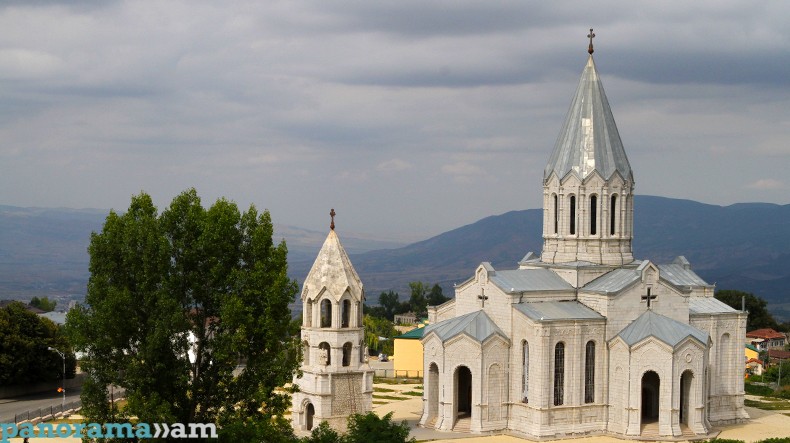
Located on one of trails of Great Silk Road Artsakh is place, where every traveler should visit once in lifetime
Artsakh (or Mountainous Karabakh) has become a place, where every traveler should visit once in a lifetime, Destination Artsakh writes.
Artsakh is a fulfilled dream for naturalists. Its wildlife thrives in ecosystems ranging from prairies and lush forests to mountains. Picturesque valleys and the canyons of rivers are the real paradises for travelers who like to have rest in a lap of the nature. Forests growing at 36% of the territory are the wealth of Artsakh. The forests are home to brown bears, wolves, wild cats, lynx, foxes, etc. The flora of the Nagorno-Karabakh is also diverse – there grow more than two thousand species of plants.
It is said, that Artsakh is famous for its ancient monasteries dating back to the early middle ages. Of special interest are the monasteries of Gandzasar, Tsitsernavank, Dadivank, Amaras, Gtchavank, Yerek Mankunk and Saint Eghishe Arakyal. The glorious past, worldwide known christian relics, the unique architecture of the monasteries give all the chances to include them in the world’s treasury of cultural and architechtural monuments.
From North to South across the Western border of Nagorno-Karabakh stretches Karabakh mountain ridge, the branches of which stretch across the region from west to east. The highest peaks of Artsakh are Gomshasar (3724), Mrav (3343 m) «Forty girls» (2828 m) the summit of Big Kirs (2725 m) and Dizapayt (2480m). The latter is famous for having a monastery on the top of it and is considered to be a pilgrimage place for mountain hikers and history lovers.
As it is noted, the climate of Artsakh is moderately soft, close to the dry subtropical climate. The average annual temperature in Celsius is 10.5 above zero. The hottest months – July and August, during these months the average temperature is 22 degrees.
Artsakh people, have preserved the age-old spiritual wealth, religion, culture, centuries-old national traditions. Armenian hospitality is famous worldwide. Any happy event is necessarily celebrated with loved ones – at home, at work, with friends. “The guest is God’s” – that sounds old saying, and indeed, in Artsakh guests are treated with love.
The article reads that from ancient times Artsakh has been and still is one of the strongholds of Christianity in the region. Believers know that, as one of the centers of Christianity in the South Caucasus, Karabakh with love and faith has kept to the days the shrines, having a sacred significance for Christians. Christianity penetrated here as early as the 1st c. CE. The main centers of pilgrimage in Artsakh remain the monastery of Gandzasar where one of the main shrines of the Christian world, the head of John the Baptist, is buried, the monastery of Dadivank founded on the burial place of one of the disciples of Thaddaeus Apostle – Apostle of Dado, monasteries of Amaras and Eghishe Arakyal built accordingly over the tombs of the grandson of Gregory the Illuminator, Grigoris, and Apostle of Eghishe (Elisha).
It reads that Artsakhian village is a unique phenomenon: more than half of the villages of the land have 500-600-years-old history; some of them were founded 800, 900 years ago. In almost every village there have remained the ancient churches, fortresses, houses and paved streets, that give the flavour of old mountainous villages of Artsakh. The lovers of agricultural tourism will get many positive emotions and impressions during their stay in the village, will get acquainted with the rural life and habits, watch all the aspects of peasants’ life and will dip into this life, so far from the urban troubles of contemporary man.
The article is also noted that Artsakh is a must visit place not only for its nature or history, but also for the events like national holidays or festivals. It is highlighted, that it is known from historical sources, one of the trails of Great Silk Road laid through the territory of Artsakh. Some monuments still remain from those times. The most famous of them are Caravanserai Gardabazar (a medieval couching inn) and Bridges of Khudaferin, which connected Artsakh to Iran and are stretched on the river of Araks.
The site also writes that there are some sites which had a connection with the route: Khudaferin bridge, Caravanserai Gagrabazar, Mets Tagher village, Amaras monastery, Shoushi city, Tigranakert, Sotk area. One can organize an original trip through this trail, discovering the ancient sites related to the Great Silk Road.
Related news
- The New York Times: Nagorno Karabakh is beautiful to look at, miserable to conduct war in
- Argentinian media: Immersed in cozy landscape around Gandzasar it is hard to believe that contact line is within hour’s drive
- TV channel BBC tells about Armenians’ lives in NKR under Azerbaijan’s permanent threats
Newsfeed
Videos






























